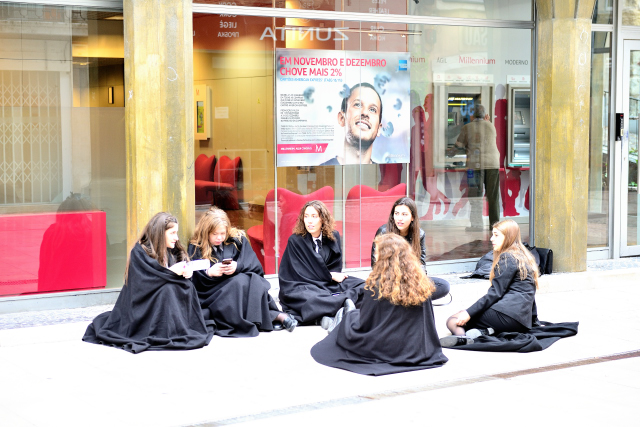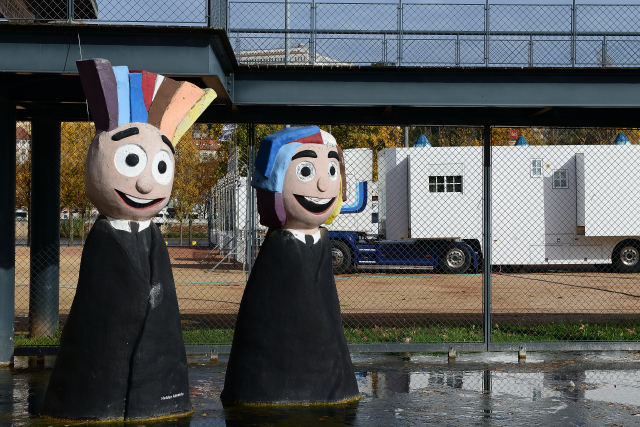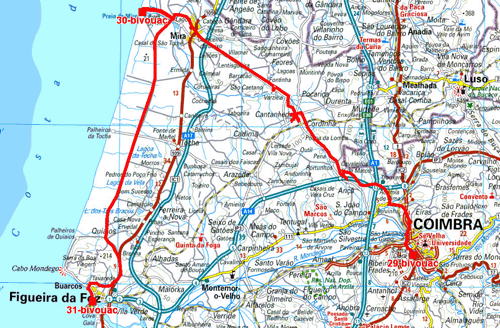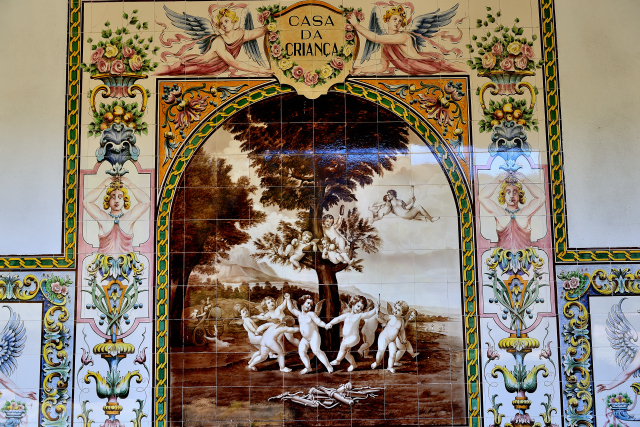Castanheira de Pêra
Monday, November 20 I attacked the Serra da Lousa medium mountain
cut by cultivated valleys but alas recurrent victim of summer fires,
again this year, whose stigmas are visible. I stopped in two villages:
The first Figueiró dos Vinhos to admire the always expressive azulejos
including the two Saint John the Baptist. The scene of beheading reminded
me the Richard Strauss' opera Salome and more particularly the dance of the
sails, prelude to the taking off of John the Baptist by order of King Herod
following his libidinous fantasies. Then Castanheira de Pêra for the
extraordinary garden and Casa da Criança (Children's House) with
a azulejo of loves dancing. I bivouacked on a parking at the bottom of the church.
Serra da Lousa, click on the pic for opening the gallery
Lousã
On Tuesday, November 21 I left Castanheira de Pêra to traverse the
en236 to the peak of the farm of wind mills where, obviously, I met
a strong wind to take the picture of the swing at approximately 1050
m of altitude. I thought naively of finding a bivouac idyllic, que
nenni, either too much wind or a dense forest of thorn-bush without
visibility nor sun to heat me and feed the solar panels. I continued
my way via Candal a thin village of shepherds fixed on the slope of
Serra da Lousã then the view-point of Nossa Senhora da Piedade
finally I arrived around midday after 45 km in search of a parking
place, on a waste ground.
Serra da Lousa-2, click on the pic for opening the gallery

|
| Candal |
Coimbra
Coimbra-1, click on the pic for opening the gallery
The old city of Coimbra is built on the Alcáçova hill whose access
is carried out by a tangle of lanes and staircases, oh it! I spent
five hours to traverse it according to the N°1 tour by the Green
Guide. Alas I did not visit by all the monuments proposed selecting
most remarkable of the medieval city. It was initially Igreja de São
Tiago of Roman style whose gate has interesting capitals. Then I
cross Carried it Almedina to enter Núcleo da Cidade Muralhada in
order to visit Museu da Santa Casa da Misericórdia with its elegant
wash-hand basin in the sacristy as well as the scriptorium. Taking my
courage with two hands I climbed the 88 steps of Torre do Relógio to
admire the panorama of the old city, in particular the dome of the
old cathedral and the towers of the news one as well as the universidade
Velha and its Clock Tower. While going up I saw two eggs of bird
which I respected “religiously”. I carried out the descent with move
back. Always while assembling the lanes I reached Sé Velha built
strengthened in 1140-1175 to resist to the Muslims. The interior is
equipped with a retable in Gothic blazing as well as a vault of
style mudéjar. I finished this first visit by Universidade Velha
registered with UNESCO in 2013,
here. The capela presents a painted
ceiling and covered walls with azulejos as well as an organ case of
the 18th century. Then Biblioteca Joanina gathers more than 3,000
books and 5,000 manuscripts, alas the reading room is NO-PHOTO
with a very vigilant supervisor… Finally I was going to throw an eye
at the botanical garden before returning to my vehicle while
descending lanes and staircases.

|
Coimbra-2, click on the pic for opening the gallery
The following day Thursday, November 23 I set out again to visit two
monasteries, Santa Clara-a-Nova and Santa Clara-a-Velha on left bank
of the Mondego river. They are two convents of nuns: The first on
the hill has the silver tomb of the queen holly Isabelle preceded by
her statue out of wooden carved by Teixeira Lopes. At side the
cloister offers a pleasant garden favorable with the meditation, in
the anteroom a pretty wash-hand basin for the ablution of the nuns.
I descended the calçada de Santa Isabel to visit the second reduced
to the state of ruin by sands of Mondego. It had received the
body of Ines de Castro transferred to Alcobaça. The center of
interpretation as well as the museum recalls its history. Before
lunching I traversed the rua de Abreu up to Miradouro to dominate
the valley of Mondego as well as the site of Coimbra. Then I devoted
a big part of the afternoon to the visit of the monastery of Santa
Cruz preceded by a renaissance gate. The church is papered with azulejos
and has a very worked pulpit as well as an imposing organ case. On
the left high altar is the tomb of the first king of Portugal,
Alphonse-Henriques (1128-1185). Being next to the church seven rooms
lodge jewels, the sacristy a paint of Ecce Homo, objets d'art-sacred,
a sober chapter house, the cloister of silence, the
elliptic sanctuary of form characterized by three retables, of the
portraits and the pyramids with relics, as well as the platform with
its stalls out of wooden very worked. I returned to my vehicle
while going to Praça da Republica. Of course it had been necessary
to stroll in the night in the old city to approach the student's life
of this ancient university town. I remained on Friday the 24th in Coimbra
to put on pages the taken pictures.

|

The GPS road tacklog
from Coimbra to Figueira da Foz
from 2017/11/25 au 2017/11/26
Praia de Mira
On Saturday, November 25 on the way towards Praia de Mira I stopped
in two villages, Cantanhede and Varziela to admire in their churches
two sculptures on stone of Ançã engraved like lace by Jean de Rouen
putting in scene
the Virgin auxiliatrice surrounded by two angels and dignitaries of
the Church. I give the details of the retable of Varziela registered
to the monument of Portugal. The departure from Coimbra was in fog
and drizzle but at the end of the morning the sky was cleared up
and the sun bored timidly with a strong wind broad on the sea front.
Of course except season there was no bather on the immense beach of
dunes. The outside temperature was 17°C.
En route N234-1, Praia de Mira, click on the pic for opening the gallery

|
| Praia de Mira |
Figueira da Foz
Sunday, November 26 was a short driving morning to go to Figueira
da Foz. Three routes were possible, highway IC-1, the road N 109
and Dunas de Cantanhede & de Quiaos. I chose the latter which proved
to be a quasi rectilinear track partially asphalted with many
pot-holes. It crosses planted dunes of conifers whose trunks carry
the traces of the fires of July. In Varziela I had requested from
the hostess of tourism office the origin of these fires, her answer
was unambiguous: “The hand of the man, cases of arson”. The town of
Figueira da Foz located at the mouth of the Mondego river is an
important fishing port, sardine and cod, as well as shipyards. It
was strengthened against the Arab invasions. It became the seaside
resort most famous of Portugal, as constructions testify at the
sea front.
En route Dunas de Cantanhede & de Quiaios, click on the pic for opening the gallery







